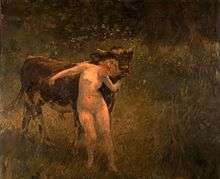Alfred Philippe Roll
| Alfred Philippe Roll | |
|---|---|
.jpg) self portrait | |
| Born |
1 March 1846 Paris, France |
| Died |
27 October 1919 Paris, France |
| Nationality | French |
| Known for | Painting, Drawing |
| Movement | Realist visual arts |

Alfred Philippe Roll (1 March 1846 – 27 October 1919) was a French painter.
Career
Roll studied at École des Beaux-Arts, where he was taught by Jean-Léon Gérôme, Henri-Joseph Harpignies, Charles-François Daubigny and Léon Bonnat. He painted his first landscape in 1869, and in 1870 exhibited "Environs of Baccarat" and "Evening" at Salon-de-Provence. During the Franco-Prussian war, he was a lieutenant of militia.[1]
His 1875 painting of "The Flood at Toulouse" attracted huge attention, and it is now in the Havre Museum. All of his early work was romantic style, but was influenced by other styles including Bolognese and Gustave Courbet. In 1877 he exhibited "Fete of Silenus" at Salon, which is now at the Ghent Museum. It was at this point Roll decided to devote his work to painting everyday life, and his style changed as well to a more realist one.
He began to paint portraits, and with his 1880 painting "Miners' Strike", he became one of France's highest ranked painters of the day; he was extremely successful for the rest of his working life. He became the French government's official painter,[2] and was commissioned to paint numerous art pieces, including those of murals, ceilings, and other building decoration. "President Carnot at Versailles at the Centenary of the Etats Generaux", now at Versailles Palace, and "The Tzar and President Faure laying the Foundation Stone of the Alexandre III. Bridge" are two such paintings, and "The Pleasures of Life" and "The Rosetime of Youth" were both for the Hotel de Ville. Many of his paintings are in public art galleries, including the Hotel de Ville museum, the Cognac Museum, Avignon Museum, Laval Museum, Fontainebleau Palace, Pau Museum, and the Museum of Geneva. In 1905 he became the president of the Societe Nationale des Beaux-Arts, which he co-founded. Jules Ernest Renoux was one of his pupils.
In the 1880s Roll "discovered" the Bordeaux artist Alfred Smith, a painter in the style of Courbet and Corot, promoting Smith's work and helping him in his career.[3]

References
- ↑ "Exhibition for Cause of Woman Suffrage". New York Times. 1915-09-26.
- ↑ Muson Bryant, Lorinda (2007). French Pictures and Their Painters. Read Books. p. 267. ISBN 1-4067-0698-1.
- ↑ Hollis Koons McCullough, ed. (2005). "Alfred Smith". Telfair Museum of Art: collection highlights. University of Georgia Press. pp. 156–157. ISBN 0-933075-04-9.
![]() This article incorporates text from a publication now in the public domain: Chisholm, Hugh, ed. (1911). "article name needed". Encyclopædia Britannica (11th ed.). Cambridge University Press.
This article incorporates text from a publication now in the public domain: Chisholm, Hugh, ed. (1911). "article name needed". Encyclopædia Britannica (11th ed.). Cambridge University Press.
External links
| Wikimedia Commons has media related to Alfred-Philippe Roll. |